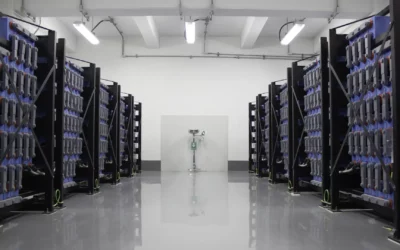• Realizing the GWP potential of SF6, the industry is shifting towards environmentally friendly alternatives.
• GIS is projected to exhibit robust growth with a CAGR of 7% in terms of revenue during the same period, with significant demand originating from renewable sources.
• SF6-free MV switchgear of the 1-24kV category, facing an earlier deadline in 2026, is anticipated to undergo the most rapid growth, with initial estimates suggesting CAGR surpassing 30% in terms of revenue during the same period.
Across Europe, gas-insulated switchgear (GIS) forms the backbone of a reliable and efficient electrical grid. However, GIS uses sulfur hexafluoride (SF6), a dangerous greenhouse gas that poses a significant threat to the environment. SF6 is one of the fluorinated gases (F-gases), and the EU is working actively to phase out the use of F-gases in Europe. The article sheds light on the deadlines for the SF6 phase-out and emerging MV switchgear market trends and outlook in Europe.

Figure 1: GWP Comparison of Some Gases.
Source: Greenhouse Gas Protocol.
Push for Alternatives
Realizing the GWP potential of SF6, the industry is shifting towards environmentally friendly alternatives. Under the European Green Deal, alternatives for SF6-based switchgear are urgently needed to meet the ambitious goal of a 55% greenhouse gas reduction by 2030. Balancing energy demands with environmental responsibility requires immediate action, making the search for sustainable solutions in the electrical switchgear sector paramount.
The EU has been at the forefront of acting against F-gases, enacting bans on their use in windows and tires since 2007. From March 2024, the revised F-gas Regulation (EU) 2024/573 has come into effect, reaffirming a steeper phase-out of F-gases from the remaining applications, building upon years of discussion and feedback from the stakeholders. For the electrical power grid industry, the deadlines for restriction on SF6-based switchgear are given below.
• Medium Voltage (MV) Primary and Secondary Switchgear <24kV: January 01, 2026
• MV Primary and Secondary Switchgear 24-52kV: January 01, 2030
• High Voltage (HV) Switchgear 52-145kV: January 01, 2028
• HV Switchgear >145kV: January 01, 2032
Effective after the deadline, the use of any f-gas in greenfield MV equipment is prohibited, as technically suitable alternatives with a GWP <1 will be available. For HV switchgear, the use of SF6 or other f-gas mixtures with a GWP > 1 will only be permitted if no OEM is offering a switchgear with an insulating medium of GWP < 1. Furthermore, starting from 2035, the use of new SF6 gas will be strictly prohibited, even for maintenance, and only reclaimed or recycled gas will be permissible. However, the regulations are lenient on brownfield projects where there are no technically suitable alternatives available. These stricter deadlines aim to accelerate the transition towards safer and more sustainable alternatives in the electrical industry.
MV Switchgear Market & Trends
According to projections by PTR, the MV switchgear market in Europe is anticipated to experience substantial growth in terms of revenue from 2023 to 2028. The air-insulated switchgear (AIS) is expected to achieve a CAGR of 4.75% in terms of revenue from 2023 to 2028, reflecting steady growth. Meanwhile, GIS is projected to exhibit robust growth with a CAGR of 7% in terms of revenue during the same period, with significant demand originating from renewable sources. The significance of GIS is evident from its major share, accounting for an estimated 60% of the total revenue in the switchgear market in 2028. As Europe experiences significant growth in MV Switchgear, particularly with the projected rise of GIS, the focus is on the emerging trends in SF6-free switchgear solutions, highlighting the industry’s commitment to sustainability and advancing eco-friendly alternatives.

Figure 2: Europe’s MV AIS/GIS Share and CAGR in Terms of Revenue from 2023-2028.
Source: PTR Inc.
Focus on SF6-Free MV Switchgear
PTR’s initial figures indicate a promising outlook for SF6-free MV switchgear, particularly those based on natural-origin gas, with a notable CAGR projected between 2023 and 2028. SF6-free MV switchgear of 1-24kV category, facing an earlier deadline in 2026, is anticipated to undergo the most rapid growth, with initial estimates suggesting CAGR surpassing 30% in terms of revenue from 2023 to 2028. In contrast, SF6-free MV switchgear of 24-42kV category, with a more distant deadline in 2030, is expected to experience growth at a comparatively lower rate.

Figure 3: CAGR for SF6-free 1-24kV MV Transformer in Terms of Revenue from 2023-2028.
Source: PTR Inc.
Way Forward
For OEMs in the MV switchgear industry, Europe’s commitment to sustainability signifies an exciting opportunity to spearhead the development and adoption of sustainable switchgear alternatives. The phaseout of SF6-based switchgear is gradual, however it is important to transition completely to SF6-free technologies to prioritize the environment. By harnessing innovation, fostering collaboration, and embracing cutting-edge SF6-free technologies, OEMs can not only comply with revised regulations but also secure a leading position in a greener future for the electrical industry.
Medium Voltage Switchgear Service Overview
The research presented in this article is from PTR's Medium Voltage Switchgear market research. For information about this service please submit a request shown below.
Europe: +49-89-12250950
Americas: +1 408-604-0522
Japan: +81-80-7808-1378
GCC/Rest of APAC: +971-58-1602441
More About our: Medium Voltage Switchgear Market Analysis
Recent Insights
The Surge of Underground Switchgear: Unveiling the Dynamics of the US Market
• The electrical infrastructure of the US is shifting to underground because of factors such as reliability and resilience, aesthetics and environmental considerations, and urban and land use. • The challenges that can impact the growth of the underground switchgear...
Electrifying America’s Future: Grid Transformation Sparks HV Switchgear Boom in the US
• To avoid transmission system congestion, the Department of Energy (DOE) has taken initiatives such as launching the Grid Deployment Office and Building a Better Grid Initiative, and, most recently, unveiling the Coordinated Interagency Transmission Authorizations...
Global Switchgear Market: Unpacking the Surge in Prices
• Owing to a range of factors, demand for switchgear has increased in the global switchgear market post-Covid, which has, in turn, increased the prices of switchgear as well. • The power sector is one of the major drivers of the demand in the global switchgear market....
Carbon Capture, Storage and Utilization: Transforming Emissions into Solutions
• CCUS technologies involve capturing CO2 emissions from industrial processes, utilizing it in various ways, and storing it permanently underground.• CCUS provides a cost-effective way to reduce GHG emissions from industrial processes, thereby contributing to the...
Middle East Energy (MEE) Conference Impressions 2023
The Middle East Energy (MEE) conference & trade fair in Dubai, which took place from 7th to 9th March, was a prime meeting place for professionals from all over the energy and power grid industry. The conference provided a platform for key equipment manufacturers...
Power Surge: MV Switchgear Market Set for Strong Growth as Grid Modernization Accelerates
The MV Switchgear market recovered in 2021, following the Covid-19 induced revenue slump, and has shown a steady growth. This infographic covers: The regional share of MV Switchgear market in all three regions, namely: the Americas, APAC and EMEA. The switchgear...
Net-Zero Commitments Encouraging Growth in Carbon dioxide Removal Technologies
Carbon removal may be achieved through nature-based methods or by employing certain technologies, such as CCS and DAC. The drive to net-zero has resulted in enhanced interest and investment in CCUS. Carbon removal technologies should act as supplements, not...







